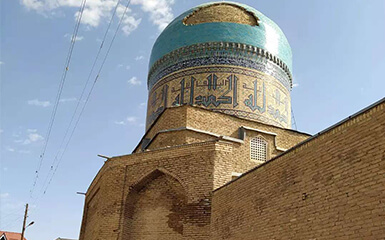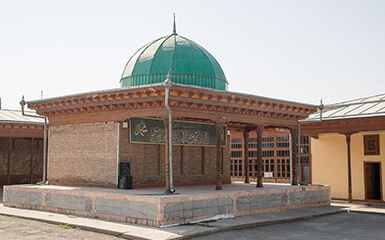Kok Gumbaz
Ajina Teppa
Ancient Panjakent
Anzob Tunnel
Beshkent Qala
Childukhtaron
Khazrati Shokh
Mug Teppa
Gharm Chashma
Hisor Historical
Haji Yaqub mosque
Hazrati-Bobo complex
Lake Iskanderkul
Kalai-Khumb
Karatag
Karon
Khishtin caravanserai
Khorog
Khulbuk
Lake Karakul
Abdullatif Sultan
Madrasai Kuhna
Abu Abdullah Rudaki
Khoja Mashhad
Khudoyor Valami
Makhmudi Azam
Mir Sayyid Ali Hamadani
Muhammed Bashoro
Sheikh Muslihiddin
Nurek Mountain Lake
Pamir
Sarazm
Sari-Khosor
Seven Lakes
Shirkent
Chiluchorchashma
Takht-i Sangin
Kok-Gumbaz - Madrasah Abdullatif Sulton

If you look at the city from above, you can see the blue dome of the Kok-Gumbaz mosque-madrasah hovering above it. It is located in the western part of the city and is named so because of the blue tiled dome (Kok-Gumbaz in Russian means "Blue Dome"). This building of the 16th century was built on the initiative of Abdullatif Sultan - the son of the famous scientist-astronomer and philosopher - Ulugbek, the grandson of Amir Timur.
The folk legend about the construction of Kok-Gumbaz says that Abdullatif, having quarreled with his father, left his parents’ house and went to an old peasant’s farm to irrigate his land. For this work, he was to receive 100 tenge. The father found out about this and took the money, honestly earned by his son, from the peasant, added his own money to them and built a madrasah with these funds. Even three centuries later, at the end of the 19th century, students studied at the madrasah.
The decoding of the chronogram, which was written above its main entrance, confirms that Abdullatif built this monument in 937 (1530-1531). This is evidenced by the archaeological excavation work on the territory of the madrasah. Judging by the documents, this building was originally intended for a madrasah (a school that teaches in different directions). The madrasah was badly damaged in 1866 during the attack of the tsarist (Russian) troops in Central Asia and the conquest of Ura-Tyube. Russian troops inflicted severe architectural damage not only on the Abdullatif Sulton Kok-Gumbaz madrasah, but also on other memorial structures in the city of Istaravshan.
The tsar's troops decided to carry out restoration work in the madrasah only 10 years later, in 1876. The paper discovered by the sublayer of the column plaster evidences this. The madrasah was restored twice more in 1904 and 1913. The earthquakes of 1897 and 1902 and the dilapidation of the building caused the two-fold renovation of this building over about 15 years. During the Great Patriotic War, the madrasah was used as a warehouse. In the 50s of the XX century, the Soviet government began restoration work in the madrasah. They lasted almost 10 years and remained unfinished. Only in 1998, on the initiative of the chairperson of the region K.R. Kasymov funds were allocated from the Sogd regional budget and the madrasahs were restored. Judging by the documents, in 1899, 44 mullobachs (students) studied in the madrasah and 8 mudarrises (teachers) taught.

